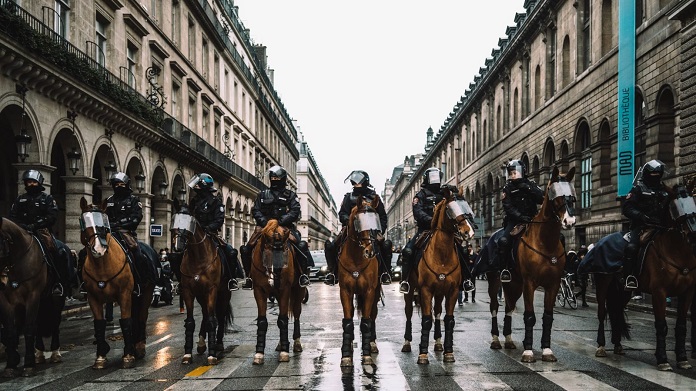
The Monopoly of Violence [NYFF 2020]
Studio: Le Bureau
Directed by David Dufresne
Sep 21, 2020
Web Exclusive
![]()
In The Monopoly of Violence, French author and director David Dufresne crafts a documentary that explores the question: how much power are police allotted, and what does that mean for common citizens?
The backstory of The Monopoly of Violence is the raising of the French carbon tax by president Emmanuel Macron in October 2018. The decision was quickly seen as a strike against working class French citizens, most of whom need a car to get to work each day and cannot afford a price hike on fuel. What followed was a series of protests, dubbed the Yellow Vests Protests. that spanned from October 2018 until June 2019. Every Saturday during these eight months, citizens around the country would don yellow vests and gather to protest against the tax decision. More often than not, the protests would become violent as protesters and police clashed; leading to injuries, looting, and infringements on human rights.
It is through the lens of these protests, that the French-language documentary tells the story. It utilizes camera footage from the protests mixed with testimonials from citizens injured from police violence and French scholars to explore the idea of state violence and what dangers can lie beneath the fabric of unchecked power.
Choosing to relay a constant stream of facts instead of trying to impress viewers with experimentalism, Dufresne’s approach to tackling the idea of police power is an effective one. Most political documentaries attempt to address too many different ideas and themes. The Monopoly of Violence’s 86 minutes are dedicated to one idea: police brutality. While some of what is presented is likely not new to viewers, it is relayed in a way that doesn’t hold back from diving deep into political and spiritual philosophy.
One of the most striking features of The Monopoly of Violence is the sheer amount of camera footage from the protests. Half the documentary is dedicated to showcasing real protestors’ experiences through the lens of their smartphone camera. The shots used are horrifying, shocking, and difficult to watch. Additionally, some of the people who recorded the footage are in the documentary themselves, filmed while looking at a screen playing their video and giving commentary about what the event was like. The documentary doesn’t hold back in showing viewers just how violent and chaotic the events were.
The documentary approaches the conversation about policing from every angle. The French citizens used in the testimonials don’t all think the same way. Their different jobs and perceptions often lead to a clashing of beliefs about the legality and legitimacy of the police’s and protestor’s actions. Part of the problem with the current methods of discourse, filtered through social media, is that many people only see and hear about things that align with their biases. By putting different interpretations and opinions of the situation on the table, Dufresne allows viewers to piece together their own beliefs on the subject, rather than telling the audience what to take away.
(www.filmlinc.org/nyff2020/films/the-monopoly-of-violence/)
Author rating: 7/10
Average reader rating: 3/10
Current Issue

Issue #72
Apr 19, 2024 Issue #72 - The ‘90s Issue with The Cardigans and Thurston Moore
Most Recent
- Sam Evian on “Plunge” (Interview) — Sam Evian
- Maya Hawke Shares Lyric Video for New Song “Hang in There” (News) — Maya Hawke
- Premiere: Anna Tivel Shares New Single “Desperation” (News) — Anna Tivel
- Nilüfer Yanya is a Runaway Bride in the Video for New Song “Like I Say (I runaway)” (News) — Nilüfer Yanya
- Storefront Church Announces New Album, Shares New Song “Coal” (Plus Live Video) (News) — Storefront Church

Comments
Submit your comment
October 4th 2020
8:40pm
Thank you! We enjoyed this thorough review, and we’ll be watching the movie soon.